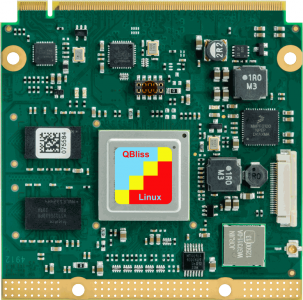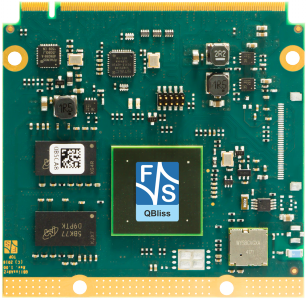Qseven/QBliss
| QBlissA9 | QBlissA9r2 | |
| State | Production | Production |
| CPU | - | - |
| CPU | NXP i.MX 6 | NXP i.MX 6 |
| Core | ARM Cortex-A9 | ARM Cortex-A9 |
| No of Cores | 1, 2, 4 | 1, 2, 4 |
| Frequency | max 1.2GHz | max 1.2GHz |
| L2-Cache | max. 1MB | max. 1MB |
| GPU | 2D, 3D | 2D, 3D |
| VPU | 1080p60 | 1080p60 |
| Security | - | - |
| Operating System | - | - |
| Linux | Buildroot Yocto (uboot installed) |
Buildroot Yocto (uboot installed) |
| Windows | WEC 7 WEC 2013 (EBoot installed) |
WEC 7 WEC 2013 (EBoot installed) |
| Memory | - | - |
| Flash | max. 1GB SLC NAND max. 32GB (uSD-Karte) |
max. 1GB SLC max. 32GB eMMC |
| RAM | max. 4GB | max. 4GB DDR3 |
| Interfaces | - | - |
| SD-Card | 1x extern | 1x extern |
| Ethernet | 10/100/1000Mb IEEE 1588 |
10/100/1000Mb IEEE 1588 |
| USB Host | 4x | 4x |
| USB Device | 1x | 1x |
| CAN | 1x | 1x |
| UART | 1x | 1x |
| I2C | 2x | 2x |
| SPI | 1x | 1x |
| Audio | AC97 | AC97 |
| Digital I/O | ||
| Touch Panel | via I2C | via AC97 |
| Camera | 0/1 | 2x MIPI-CSI |
| PCIe | 1x | 1x |
| SATA | 1x | 1x |
| Display | - | - |
| LVDS | 2x 18/24bit | 2x 24bit |
| CRT/DVI | 0/DVI | 0/DVI |
| Common | - | - |
| V_IN | +5V DC/ ±5% | +5V DC/ ±5% |
| T_AMB | 0°C - +70°C -20°C - +85°C |
0°C - +70°C -20°C - +85°C -40°C - +85°C |
| Size | 70x70x11mm | 70x70x11mm (LxBxH) |
| Availability | 2035 | 2035 |
| QBlissA9 | QBlissA9r2 |
The Qseven form factor was defined by the board manufacturers Congatec, MSC and Seco. Meanwhile the member list is a couple of pages long.
Initially, Qseven was designed for Intel ATOM CPUs. We deal with with RISC CPUs and operating systems like Windows Embedded CE and embedded Linux for more than 10 years.
This knowledge resulted in compact form factors like PicoMOD (80mm x 50mm) and PicoCOM (40mm x 50mm).
We now offer -as one of the first manufacturers- a RISC board in the Qseven form factor. It offers customers using a Qseven with ATOM CPU the opportunity to switch to a compatible board with RISC CPU. More than 90% of the Qseven Standard (70mm x 70mm) designated interfaces get served. So QBliss is applicable in many Qseven applications instantly without having to change hardware.
So why should a customer switch from Qseven with ATOM to one with RISC?
It has a lot to commend it:
- Low power (less than 3 Watt)
- Short booting time (5-8s)
- Low license costs for Windows Embedded CE 6.0 R3 or Windows Embedded Compact 7
- Inexpensive Price
More applications become available especially in mobile devices where compactness, energy-saving, low-cost, robustness and reliability are important factors.






